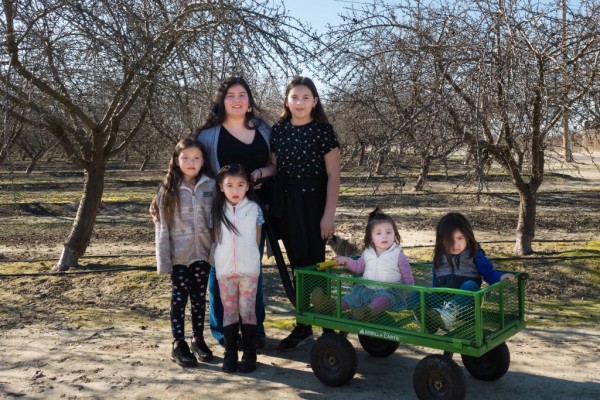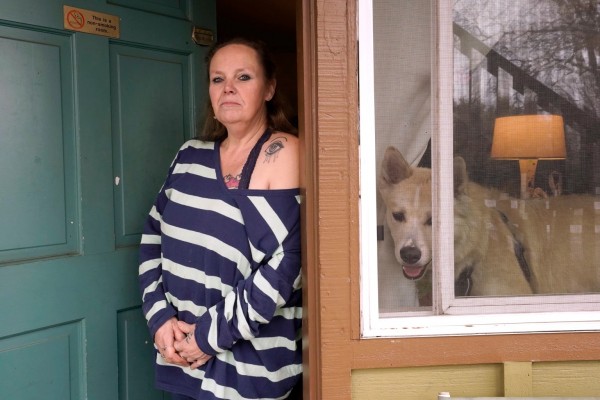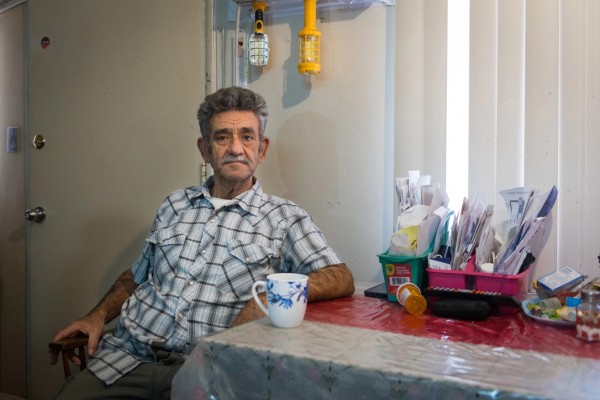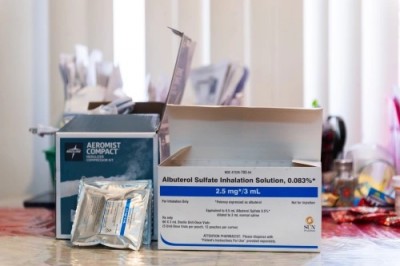
Carolina Morga Tapia with her five children (from left), Isela Nuñez, Emma Nuñez, Isabella Nuñez, Natalie Nuñez, and Giovanni Nuñez. Morga Tapia says the family’s Medi-Cal plan has been a godsend. “It saves a lot of money, and it’s a blessing to have that extra help.” (Heidi de Marco / KHN).
By Angela Hart and Bernard J. Wolfson
Newborns. Former inmates. College students. Expectant moms. People with disabilities. Foster kids. Homeless people. Single dads.
Your neighbor. Your co-worker.
You.
California’s Medicaid program, called Medi-Cal, serves a whopping 15.4 million people, offering care from cradle to grave: Half of all births are covered by Medi-Cal, as are more than half of all stays in nursing homes.
Everything about Medi-Cal is massive, from its upcoming fiscal year budget of $139 billion to the expansive list of benefits and services it offers. The way the program works — or doesn’t — could spell life or death for many enrollees.
“It’s critical, from the single pregnant mom, to the extremely frail elderly population that needs a nursing home,” said Jennifer Kent, former director of the state Department of Health Care Services, which administers Medi-Cal. “If it weren’t for Medi-Cal, so many people would either be dead or would be severely compromised.”
In a new series, California Healthline will shed light on Medi-Cal’s successes and failures through the experiences of its enrollees. They include Stephanie Lammers, who can’t get her troubling abdominal symptoms checked at a clinic 50 miles from her small Calaveras County town because the transportation Medi-Cal is supposed to provide isn’t trustworthy; Carolina Morga Tapia, a Fresno woman who credits Medi-Cal with helping her have five healthy children; and Lucas Moreno Ramirez, a Los Angeles County man with stage 4 lung cancer who had to fight to keep his treatment going.
Medi-Cal is at a critical juncture as it attempts to serve the needs of a diverse patient population with a dizzying array of medical needs — from childhood vaccinations and cancer screenings to state-of-the-art care for rare genetic disorders. Roughly half of enrollees are Hispanic, and, next year, California will become the first state to expand eligibility to all immigrants who qualify, regardless of their legal status.
Medi-Cal is also undertaking several new initiatives that aim to save taxpayer money and improve quality. State officials are demanding that the 23 health insurers that serve most Medi-Cal patients provide better care — or face significant penalties, including potential expulsion from the program.
The state is also adding innovative social services that fall outside the traditional realm of medicine, including helping some enrollees pay for rent and buy groceries.
“People are watching California,” said Cindy Mann, who served as federal Medicaid director under former President Barack Obama. “What the state is doing is ambitious and very aggressive. It makes a significant mark on health care and health policy, not just because of the size and breadth of its program, but by being very comprehensive.”
But only a sliver of enrollees will get the new social services, even as many patients struggle to obtain basic care or get in to see their doctors. In reality, the type of care you get in Medi-Cal depends on where you live and which insurer provides your benefits.
That means the program is working for some, but failing for many others.
If you are in Medi-Cal, we would like to hear from you, whether you live in a big city or a rural region, regardless of your age, race, or ethnicity, and whatever your medical, dental, or mental health condition. Have you had difficulty seeing the right doctor for what ails you, even to the point of putting your life at risk? Or did Medi-Cal provide good care, perhaps sparing you serious harm or disability? Either way, please consider sharing your experience with us.
Here are snapshots of patients who have used the program at a critical time in their life.

Stephanie Lammers says the ride service provided by her Medi-Cal health plan is so bad that she stopped trying to use it about a year ago, after it left her in the lurch multiple times. “I just don’t go to the doctor anymore,” she says.(Rich Pedroncelli for KHN).
‘I Just Don’t Go to the Doctor Anymore’
When Stephanie Lammers leans over to put on her shoes, it feels as if she’s squishing something inside her abdomen, she said.
Lammers, 53, has been suffering from frequent bouts of nausea, pain, and bloating for six months.
Her gastroenterologist wants to perform diagnostic procedures, including a colonoscopy and, if anything shows up, a biopsy. But Lammers, who lives in a motel with her boyfriend and teenage daughter in the Gold Rush town of San Andreas, doesn’t have a working car and can’t readily get to the clinic — which is 50 miles away.
For Lammers, like many Medi-Cal enrollees who live in rural areas, lack of transportation is a major impediment to obtaining care. The problem is particularly acute for patients who need to see specialists.
Lammers’ dermatologist and eye doctor are over an hour away from San Andreas, the county seat of Calaveras County, about 125 miles northeast of San Francisco. She isn’t seeing a neurologist, despite a series of mini-strokes and stress-related seizures. And she hasn’t been to a podiatrist in two years, even though her toes are twisted over one another and hang down, causing her to trip. She’s often in excruciating pain when she walks.

Stephanie Lammers, pictured with her dog, Shinook, has terrible pain in her feet. She frequently trips because her toes cross over one another and hang down, but she hasn’t seen a podiatrist in two years. (Rich Pedroncelli for KHN)
Medi-Cal is supposed to provide free transportation to enrollees who can’t otherwise get to their appointments.
But Lammers, whose health plan is California Health & Wellness, owned by Centene, the nation’s largest commercial Medicaid insurer, stopped using its ride service nearly a year ago, after she missed dozens of appointments because drivers just didn’t show up, she said. She was getting threatening letters from doctors’ offices over the no-shows.
Once she had to hitchhike more than 30 miles home from a counseling appointment. On other occasions, Lammers said, she did not receive the reimbursement she was owed for arranging her own rides.
“I just don’t go to the doctor anymore,” Lammers said. “If I go to the doctor, my boyfriend has to take the day off work, and if he takes the day off work, we have no money.”
During the last three months of 2022, Lammers canceled five appointments she had scheduled for the diagnostic abdominal procedures because her boyfriend had to work each time and couldn’t take her. She finally stopped rescheduling.
California Health & Wellness contracts with Modivcare, a Denver-based medical transportation company that is no stranger to patient complaints and lawsuits.
Before she gave up on the ride service, Lammers said, she would call California Health & Wellness to try to resolve the issue, only to be told that Modivcare was a separate company. “I’m like, ‘If you guys hired them and put them in charge of transportation, who oversees their screw-ups?’”
Courtney Schwyzer, a member of a legal aid team representing Lammers on various Medi-Cal matters, said the failure of medical ride services is a systemic problem. In late February, Schwyzer and her fellow attorneys filed a petition in court that she hopes will force the state Department of Health Care Services to address the problem.
California Health & Wellness spokesperson Darrel Ng said the company monitors the quality of its contractors, but a shortage of transportation providers in rural areas “has created unique challenges.”
Modivcare provides more than 4 million rides for Medi-Cal recipients annually, and more than 99% are without complaint, said Melody Lai, a company spokesperson.
Lammers, who is unemployed and trying to start a custom craft business called Stuff by Steph, said doctors have warned her that if she doesn’t reduce her stress level, it could shorten her life. But arranging medical care is the most stressful thing in her life right now, so she doesn’t try anymore.
“In order to keep from dying, I have to not go to the doctor,” she said.

Carolina Morga Tapia stands amid almond trees outside her home in Fresno, California. She, her husband, and their five children are enrolled in Medi-Cal, and she says she is very happy with the care it has provided, including emergency surgery that saved her life after she fell gravely ill during her second pregnancy.(Heidi de Marco / KHN)
‘It’s a Blessing’
Medi-Cal helped save the life of Carolina Morga Tapia, a 30-year-old, full-time mother of five who lives with her family amid almond groves in an agricultural enclave of Fresno.
Nine years ago, a bacterial infection triggered premature labor during the 25th week of her second pregnancy, and Morga Tapia almost died. She spiked a fever, bled profusely, and needed immediate transfusions and emergency surgery. After several days in critical care, she fully recovered.
But the doctors could not stop the premature birth, and her baby came out weighing just 1 pound. She and her husband, David Nuñez, named her Milagros Guadalupe, and she died four days later, on Sept. 13, 2013 — a Friday.
In each of her subsequent pregnancies, Medi-Cal paid for Morga Tapia to get shots of synthetic progesterone, intended to prevent another preterm birth. Those shots — one a week for about 20 weeks — can cost an average of more than $10,000 per pregnancy.
Morga Tapia and Nuñez, a construction worker, signed up for Medi-Cal when she was pregnant with her first child more than a decade ago. They’ve been on the same Anthem Blue Cross Medi-Cal plan ever since.
The plan paid for prenatal care through all six of Morga Tapia’s pregnancies, and it has provided all the medical and dental care the family needs, she said.
“Without Medi-Cal, we would have to be paying for all of our children,” said Morga Tapia. “It saves a lot of money, and it’s a blessing to have that extra help.”
Her children, four girls and a boy, range in age from 1 to 10. They all go to the same children’s clinic and see the same pediatrician.
The kids, all in good health, get routine checkups, vaccinations, and other preventive care, Morga Tapia said. She gets appointment reminders via text and cards in the mail notifying her when it’s time for the kids’ vaccinations and wellness checks, as well as her Pap smears, she said.
Her family’s experience contrasts sharply with the state’s assessment of their health plan, according to a report on quality of care in Medi-Cal issued late last year. The report, which evaluated Medi-Cal health plans on pediatric care, women’s health, and chronic disease management, put Anthem Blue Cross in the lowest tier, and below par on multiple measures in numerous counties, including Fresno.
Another state report, released in late January, detailed how quickly insurers provide appointments for their patients, and put Anthem Blue Cross’ Medi-Cal plan near the bottom of the heap.
Anthem Blue Cross spokesperson Michael Bowman said in a statement that the period covered in the reports coincided with the covid-19 pandemic, “when our safety net providers dealt with significant challenges with workforce and appointment availability.”
Morga Tapia doesn’t give the insurer low marks. “It’s different for everybody. I have a good healthy family, and what Medi-Cal covers is really fortunate for us,” she said.

Lucas Moreno Ramirez has late-stage lung cancer, and in 2021, doctors gave him only a few months to live. But the Los Angeles County man declined hospice and fought for a different treatment. Two years later, Moreno Ramirez is still alive and says his painful cough has subsided.(Heidi de Marco / KHN).
‘I Don’t Want to Die Yet’
In late 2021, doctors gave Lucas Moreno Ramirez a few months to live.
Struggling with diabetes and late-stage lung cancer, Moreno Ramirez suffered debilitating pain as he hacked and labored for breath. His doctors recommended that he stop treatment and start hospice care.
He felt as if they were giving up on him.
“They said they’re going to give me opioids for my pain and help me have a comfortable death,” said Moreno Ramirez, 68, who lives in Norwalk, in Los Angeles County. “I told them I don’t believe in that. I don’t want to die yet.”
A former landscaper and factory worker, Moreno Ramirez learned he had to be his own advocate, fighting for the care he believed he deserved from Medi-Cal.
He said his Christian faith gave him strength, and over the next few months, Moreno Ramirez pushed the program and his doctors to keep battling his cancer, using a different treatment with fewer side effects than chemotherapy.
“I believe in prayer,” he said. “But I believe in science and medication, too.”

Lucas Moreno Ramirez has taken his care into his own hands and says he’s no longer in pain, his cough has subsided, and he feels hopeful for the future.(Heidi de Marco / KHN).
Moreno Ramirez is one of the roughly 1.6 million Californians enrolled in both Medicare, which covers people who are 65 and older or have disabilities, and Medi-Cal, which kicks in to cover the costs and benefits that Medicare doesn’t.
He also relies on his Medi-Cal insurer to help him navigate the byzantine system. L.A. Care, the largest Medi-Cal plan with nearly 2.6 million members, connected him with a care manager who worked with him to identify a different treatment called Tagrisso and advocated for him to get it.
Even with the new medication, Moreno Ramirez’s coughing fits returned last year, and his symptoms grew so painful he suspected the cancer was growing. He asked to see his pulmonologist but was told the first appointment would be in June 2023. So he switched doctors and scored an appointment nearly six months sooner.
“My old doctor didn’t help me. I didn’t trust him,” Moreno Ramirez said. “He was always too busy for me. I told my doctors, ‘Give me a chance.’”
Having taken his care into his own hands, he says he’s not in pain, his cough has subsided, and he feels hopeful for the future. “Now I feel good,” he said.
He has also sought more attention for his diabetes and received a continuous glucose monitor to measure his blood sugar. It’s better controlled now than it has been in decades, he said.
“You have to stand up for yourself and advocate,” said Joann Pacelo, the care manager who helped Moreno Ramirez change doctors, get quicker referrals to specialists, and get approved for in-home nursing visits.
“A lot of times it’s difficult with Medi-Cal because the doctors are busy and the reimbursements are so low, but no one should be denied the care they deserve.”













